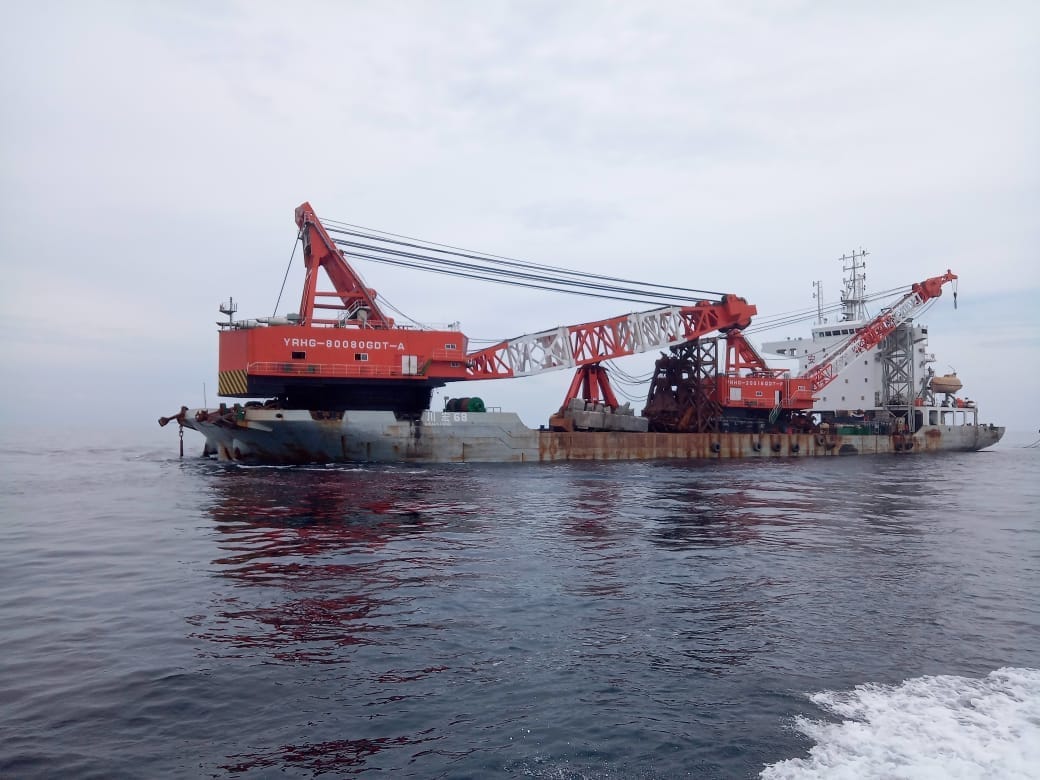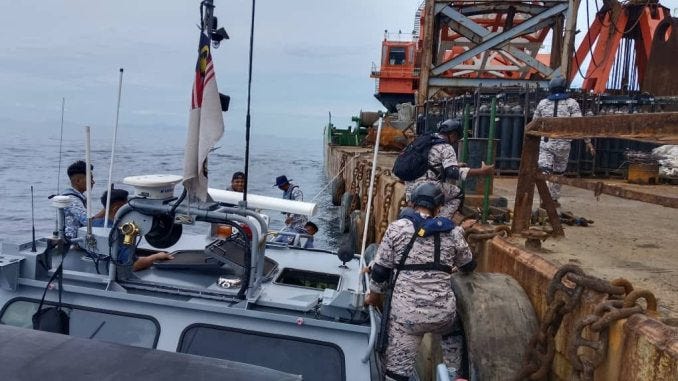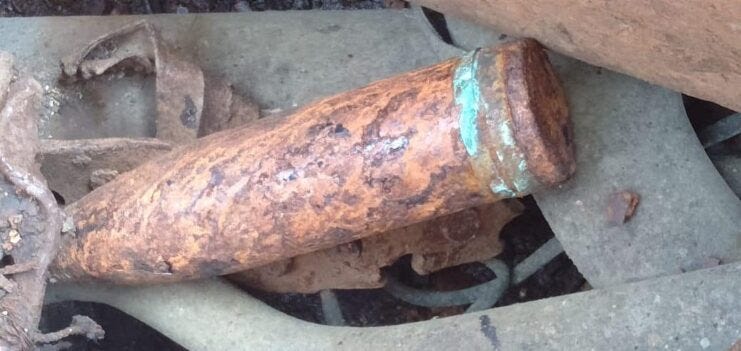Scrap Pirates
How historical ships are being plundered long after their final voyage
by Santiago José del Castillo Toquero
A wake-up call
By the end of May 2023, a similar headline started appearing in social media and international news: The wrecks of HMS Prince of Wales and HMS Repulse, historical vessels that served the Royal Navy during World War 2 as part of the Task Force Z, had been desecrated and looted by illegal scavengers.
Despite the great commotion that this news caused, this is a problem that has been taking place for more than ten years, and that involves a complex framework that involves private and public actors, national and international interests, and great power competition. It is a systemic Maritime Security problem such as piracy, IIU fishing or smuggling, and as of today it has yet to be properly addressed. Thus, this article aims to raise the public awareness regarding this topic, as there are only waves of support and concern every time that an incident takes place. However, there is no ongoing discussion when it comes to tacking this recurrent issue.
The Chuan Hong 68. Dredger or grave-digger?
The perpetrator of the destruction of the HMS Prince of Wales and HMS Repulse was the Chuan Hong 68, a repurposed Chinese barge that had been equipped with high-end dredging equipment such as hydraulic cranes and claws, turning the vessel into a multipurpose platform with deep bottom dredging capabilities. From December 2022 until 2023, the ship roamed freely and undetected, carrying out numerous illegal salvage operations on the historical wrecks; in many cases, the Chuan Hong stayed over the wreck for days, using its cranes to destroy and grab the metal of the warships.
This vessel was already renown for her illegal salvage operations of historical shipwrecks. Some sources indicate that these activities spanned for more than ten years, and the vessel was involved in the desecration and looting of other historical shipwrecks, such as IJN Sagari, Hiyoshi Maru, and Katori Maru in 2017 and IJN Haguro in 2022.
The vessel had been detained in May 2023 by Malaysian authorities, under the suspicion of illegal looting of historical shipwrecks, including Prince of Wales and Repulse. The vessel was boarded and inspected by the Malaysian coastguard, which found numerous evidences such as cannons and ammunition that corresponded with the aforementioned shipwrecks. The crew was taken onshore to be interrogated, but when the authorities returned to the vessel, they realized that, somehow, the Cuang Hong 68 had managed to escape.
Once again, the Chuan Hong 68 arrested in July 2024 by Malaysian authorities. The vessel was detained and the crew was questioned, but not because of the previous episodes of illegal salvaging on historical shipwrecks, but for numerous port and documentation violations. The vessel was later on released and is still sailing freely today. By the moment this article is text is being written, the Chuang Hong 68 was last seen off the coast of South Africa.

The looting case of the HMS Prince of Wales and HMS Repulse caused great sorrow in the hearts of the families of those served when the warships sank back in December 1941. Military authorities of the Royal Navy, as well as professionals from the underwater archaeology sector, expressed their disgust and their concern with the situation. The director of the National Museum of the Royal Navy, Professor Dominic Tweddle, issued a statement after the first detention of Chuan Hong 68 in May 2023:
“We are distressed and concerned at the apparent vandalism for personal profit of HMS Prince of Wales and HMS Repulse. They are designated war graves. We are upset at the loss of naval heritage and the impact this has on the understanding of our Royal Navy history.”
This feeling of concern was mixed with the sudden realization that the historical shipwrecks that sprawl all around the world; heralds of the history of many nations and final rest for many souls, were no longer sacred. Of course, occasional looting and artifact hunting have always been challenges faced by the authorities responsible for the monitoring of these wrecks. However, the challenge that these big-scale scavengers posed was bigger than the capabilities and procedures developed by the affected nations.
Countries like the United States have issued laws like the Sunken Military Craft Act of 2004, which enables the designation of every U.S. naval shipwreck, including aircraft, as war graves, no matter where they are located. In addition, it establishes a strict framework that includes judicial consequences for the perpetrators. However, most of the existing legislations have certain challenges when it comes to being applied in international waters or waters belonging to another country. In the case of Southeast Asian countries, this is especially challenging. These regulations are focused on the designation and importance of the wrecks, but lack the legal framework to face and prosecute illegal salvaging operations in foreign waters; in these situations, the actions depend on the riparian state, and great diplomatic efforts are needed in these cases.
Modus operandi: Search. Destroy. Profit
The main line of work for these scavengers makes it extremely complex to track and obtain evidence of their actions until it is too late. This is the reason why, except for very few exceptions, vessels like the Chuan Hong 68 are still operating freely.
The scavenging vessels are operated by local Indonesian and Malaysian companies, which engage in dredging operations all around Southeast Asia. Dredging is a practice that is needed in the Maritime Domain, as it enables the installation of infrastructure, the opening of sea lines, and the cleaning of the seabed, among many other benefits. However, it is relatively easy to hop from a legal to an illegal framework in a matter of seconds.

Dredging vessels operate under permits issued by the corresponding departments of the Ministry of Transportation or Infrastructure of the country in question. These permits allow the vessel to lift specific shipwrecks from the seabed, mainly because their location affects the local traffic or because they can pose a threat to navigation. While the removal of these wrecks is legal and contemplated under the national jurisdiction, sometimes the vessels that are performing these dredging actions deviate from their course and take advantage of their location to plunder nearby shipwrecks. AIS manipulation and spoofing are common practices during this process, as they allow the scavengers to act for several days over non-authorized shipwrecks without being monitored – a practice that, in the case of Malaysia, for example, is punishable by law. Then, they mix the scrap obtained from the illegal salvage operations with scrap legally obtained from designated wrecks, and deliver it to different dumping areas in the country, making the tracking of shreds of evidence extremely complex.
Furthermore, the issuing of these permits has been used by the crews of the scavenging vessels as waivers to get away from any kind of punishment, arguing that they are carrying out legal activities despite deviating from their planned routes in numerous cases.
In order to make this even more complicated, the vessels manipulate their IMO numbers and other identity characteristics, sometimes sharing their IMO number with another vessel, changing flags, or using modified AIS transponders that allow them to operate more covertly.
The scrap metal obtained from these shipwrecks, however, is worth the risk. Known as low-background steel in the physician community, it comprises the metal that was processed prior to the beginning of the nuclear era. The radioactivity levels of steel produced before 1945 are hundreds and thousands of times lower than steel made today, making it extremely suitable for high-end technology such as the creation of laboratory or space exploration equipment, which requires the lowest level of radiation possible. While common steel can be processed into low background steel, it is extremely costly, which makes historical shipwrecks “natural sources” of this valuable metal, free for the taking, and with a revenue of more than ten times than the normal steel.
The network of historical shipwreck scavengers; an international challenge
While the earlier activities of the Chuan Hong 68 prior to the looting of HMS Prince of Wales and HMS Repulse did not spark many repercussions in the international media, a series of events that took place in Indonesia between 2014 and 2018 showcased the seriousness and complexity of these incidents.
Pioneer 88, a grab dredger barge with a similar configuration as the one of Chuan Hong 68, was one of the main protagonists of an investigation carried out by the Indonesian Government and independent researchers after it was discovered that the wrecks of Dutch warships had been looted and numerous pieces of evidence indicated the participation of this vessel in the scavenging operations. Eyewitnesses from the company that owned Pioneer 88, PT Jatim Perkasa, and physical evidence found at the scrapped dump yards where the company operates, such as the presence of artifacts belonging to Dutch warships or even the disposal of human remains found among the scrap, were insufficient to prove the company guilty. The company still operates today and offers salvage services in Southeast Asian waters.

The list of suspicious vessels accused of having looted historical shipwrecks in the area is long. Aside from the previously mentioned Chuan Hong 68 and Pioneer 88, the Hai Wei Gong 889, since 2012, looted the Japanese warships IJN Kuma, IJN Haguro, and Chosa Maru, as well as the German and Italian-made submarines U-boat 859 and U-IT 93. In addition, it is suspected of having looted the Dutch submarines HNLMS K-XVII and HNLMS O-16. The Malaysian authorities, however, reported not being aware of such activities.
The Ji Chang 5 is another scavenger vessel, which was caught by divers in the middle of the looting of the wreck of a Swedish tanker, the Seven Skies, off the Riau Islands. A wreck once beloved by the local diving community for its biodiversity and beautiful scenery was now lost in the blink of an eye.
The vessel KBR Benoa 1, on the other hand, was caught by the local community of Muntok, West Bangka, while looting the wreck of a Japanese heavy cruiser IJN Ashigara. The Armada Salvage 8 was caught in 2016 taking the wreck of a historic ship in Tokoli waters of Riau Islands. In this case, the actions were investigated and the crew was brought to court for violating shipping laws. Furthermore, this vessel is linked by ownership to the MV Laut Lestari, also accused of looting historical shipwrecks in the area.
Looking at these cases from a bigger-picture perspective, it is possible to find unexpected correlations that further complicate the addressing of this challenge. All the above-mentioned vessels, despite being operated by Indonesian and Malaysian dredging companies, have hidden ties to Chinese businessmen and entrepreneurs. Out of eight grab-dredgers linked to illegal salvaging operations, five operating in Southeast Asia were exported by Fujian Jiada Ship Import & Export, a company based in Ningde, Fujian (China). Lin Xu Liang, secretary of Fujian Jiada admitted that the company had provided these vessels. In addition, he further admitted that the company leads its own dredging operations:
“They lift many ships from the seabed. If they are lucky, they often get shipwrecks from World War II. Xu said that ex-World War II ships make more money than ordinary shipwrecks. It's hard to say, but sometimes we can find ancient warships and sailing ships like we see in movies”.
Xu also said that his company often finds treasure on these shipwrecks which are extra revenue sources for the company: "If we are lucky, we also find gold coins. It is hard to say what we take. If you are lucky enough to find it, you can make more money. Usually, it is difficult to find gold coins. It is like buying a lottery. You buy the lottery every day and dream of hitting the jackpot." These statements, while coming from a representative of a shipping company, could easily come from a treasure hunter instead. Since 2018, the company has harshly reduced its public visibility.

In addition, all the companies that operate these dredgers, including those not directly related to Fujian Jiada Ship Import & Export, are in one way or another related to businessmen from Fujian: company shareholdings or even family relations between Indonesian and Chinese citizens ensure and prove the relationship of these looters with China. This connection is also observable in the presence of Chinese workers and personnel in both onshore and offshore operations. Finally, it is important to highlight numerous shipments of the processed metal are later shipped to China via Chinese-owned companies in Indonesia and Malaysia.
Local government officials have also been involved in these operations, by issuing the wreck removal permits and, on some occasions, being bribed by representatives of these companies, allowing them to carry out their operations in areas where there was no real interest in a dredging operation, but the location in question was close to a potential historical shipwreck, making the illegal deviation less evident. Between 2014 and 2018, two Directors of the Department of Transportation of the Republic of Indonesia were consequently prosecuted under the suspicion of corruption. However, low and middle-grade officials who are likely involved in these operations are still active in their corresponding positions.
This network of illegal shipwreck scavengers is, in a way, an extension of the Chinese influence in Southeast Asia, shrouded in a grey area framework that enables the engaging of illegal salvaging operations, the corruption of government officials, and the obtainment of profit – both economic and technological, at the cost of the destruction of foreign cultural heritage.
A challenge unanswered
The inactivity of the local governments, the inefficient legislation, and the complexity that surrounds the perpetrators of these plunders on historical shipwrecks, present a very challenging scenario that, as of today, has not been answered yet. While numerous initiatives have taken place to try to enhance the protection of these historical wrecks, these "scrap pirates" are still on the loose and continue to carry out their operations unaffected, enjoying the legal loopholes and unpolished frameworks that affect this area.
The desecration of these shipwrecks implies an irreparable loss of cultural heritage and the destruction of the final resting places of people who gave their lives for their country. However, it also represents the active removal of common history and heritage, represented by these shipwrecks, that links countries together, making it easier for other actors to replace that history and thus expand their area of influence. Furthermore, it is highly likely that, if this issue is not addressed, it can easily expand its effect to other areas of the globe.
For this reason, direct cooperation, dialogue and understanding between national and international like-minded partners, both from private and public backgrounds, are key elements that need to be implemented, as soon as possible, in order to prevent further destruction of our common underwater heritage.

